The XM734 was a regular M113 prepared by FMC with modifications to enable fire on the move, from inside the crew compartment, which presented a danger with the internally mounted fuel tank. The two XM765s tested at Aberdeen were asked for to FMC followed. None of these modifications went to production but further work led to the exported YPR 765 or XM-21.
The concept of mechanized infantry following and supporting tanks, like the German panzergrenadier, was a concept that was looked for, in the US, knowing that the Soviet Union was also looking at the concept and preparing a dedicated new design. Until then on their side, the current APCs such as the BTR-152 were wheeled vehicle, lightly protected and armed. They lacked tracks to followed the tanks enywhere and were too sensible to artillery. A long process started, via the BTR-60 and a long line of wheeled APCs towards a tracked vehicle that became the BMP-1.
In the US, a 1963 "Study of Alternatives for a Post 1965 Infantry Combat Vehicle" advocated for a new, high performance mechanized infantry combat vehicle known as the "MICV" to servd with the new main battle tank.

XM-734
The US Army Infantry School at Fort Benning started by itself to study the matter, taking a regular M113 APC and toying with new ideas. They first looked at the position of infantry sections, by having them seated on benches facing outwards and back-to-back, facing the walls, or to be precise, gun ports and sights that were practicable in these. This combination of vision slots and free-moving pintle like gun ports or simple slots protected by folding shutters were for the first time bringing fire on the move.
This idea was simple: How to deal with enemy closing infantry threatening tanks ? A standard APC let the infantry dismount to deal with the threat, but it was putting it at risk, under enemy fire perhaps from well protected positions. The obvious was to allow them to fire on the move, from inside the vehicle for best protection. The BTR-152, again, already put out a simple solution by having three gun ports on each of its walls. Thus, Soviet Infantry in standard had these protection so was for each and every APC (BTR-60 and 70) to some.
For the US Army Infantry School it came as an evidence that US-built APCs lacked this capability; This was not straighforward though, and many objected this experiment: They argued that -Having men firing on the move only brough poor accuracy to say the least.
-Plus, in the context on NBC warfare, this was a potential leak of the integrity of the hull.
-Also, some argued that the regular M113 already had that capability, when lifting up the rear roof hatches. Men just had to stand and fire, with even a greater field of view.
But it was clear nevertheless something needed to be done: From 1940 to 1955, the M39, M44, M75, and M59 were all unsatisfactory and never fully met Army requirements. Only the 1958 XM113 became a match, followed by mass production. Its aluminum alloy body meant better tactical mobility thanks to paradropping delivery, amhibious qualities, and still well protected against small armed fire and shrapnel. But they were unable to use their weapons until exiting the vehicle. This made the M113 a “battle taxi” which had its limits in wartime: As the Vietnam War started the first year it was used, the M113 proved unsuitable for mounted warfare and just four men could fire while standing up though the rood hatches, partially exposed to enemy fire, and pintle-mounted, 7.62mm machine gun well completed the .50-caliber HMG. Soon, armor shielding protected all three gunners, creating the armored cavalry assault vehicle (ACAV). In December 1965, FMC received directives to modify six M113 as "infantry fighting vehicles", modified with four sets of vision blocks and firing ports on either side, and two in the rear ramp. These vision blocks and firing ports were recessed to keep the width intact and simplify standardization with the regular M113. The original sponson mounted fuel tank however was replaced by a 100 gallon fuel tank, installed in the center of the vehicle. So right in the middle of the crew compartment.
In December 1965, FMC received directives to modify six M113 as "infantry fighting vehicles", modified with four sets of vision blocks and firing ports on either side, and two in the rear ramp. These vision blocks and firing ports were recessed to keep the width intact and simplify standardization with the regular M113. The original sponson mounted fuel tank however was replaced by a 100 gallon fuel tank, installed in the center of the vehicle. So right in the middle of the crew compartment.
This was also linked to the crew seats relocated along the center, facing outward, toward the gun ports while personnel capacity was reduced from 13 to 12. To help with cooling, a compartment ventilation blower was installed. The other major modification was the original M113 type cupola removed and replaced by a Model 74c cupola. It was fitted with two manually operated .30 caliber machine guns. Also two of the six vehicles were fitted with bar armor for protection against shaped charge (HEAT) projectiles. The conversion was completed in March 1966, and they were submitted for troop evaluation at Aberdeen proving Ground.
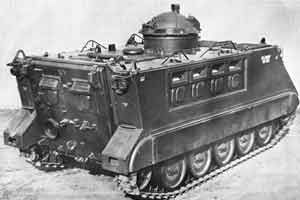 The XM734 was a modified M113 with a centrally mounted one-man enclosed gun cupola carrying in its first version two heavy Machine-Guns, and an optional rear pintle to mount a recoiless rifle, twi more pintles for light machine guns, firing through its top hatch. Also in this version version, and more importantly, a plate as removed and a new one with vut-out openings were added to increase further this firepower, with three vision blocks and three gun ports below, each with a sliding slit. This prototype was integrated to the new MICV-65 program.
The XM734 was a modified M113 with a centrally mounted one-man enclosed gun cupola carrying in its first version two heavy Machine-Guns, and an optional rear pintle to mount a recoiless rifle, twi more pintles for light machine guns, firing through its top hatch. Also in this version version, and more importantly, a plate as removed and a new one with vut-out openings were added to increase further this firepower, with three vision blocks and three gun ports below, each with a sliding slit. This prototype was integrated to the new MICV-65 program.
This debate eventually generated a report that was sanctioned at an upper echelon to grant the study of a proper prototyping programme, to be joined to the MICV-65 program at large. At the time the "Infantry Combat Vehicle" (ICV was in full swing, three main proponents were working on lesst rival that complementary approaches:
-Pacific Car and Foundry was working on the XM701, based on the smaller, faster M110 self-propelled artillery chassis
-FMC,the manufacturer of the M113 proposed a much-improved model, called the XM734.
However inside the program, it appeared clearly that the XM701 was more promising, notably for performances, and was selected for further improvements. On the other hand, the XM-734 was given the greenlight for evaluation on some aspects that could be useful for the new ICV on the long run, testing armaments and fire on the move solution, regardless of performances.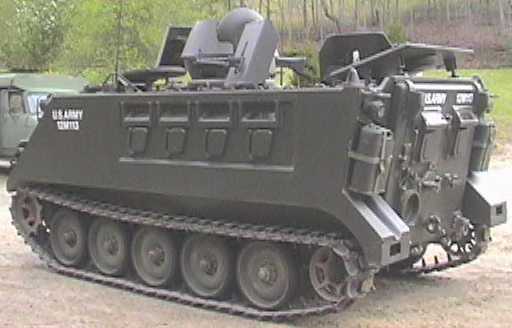
In 1967 also, based on the first reports from Aberdeen, FMC received a contract to modify two M113A1 as prototypes to evaluate also the "fight-from-the-vehicle" concept. They were designated as the XM765 and were identical to the standard M113A1 mechanically but with an upper rear side armor sloped, four sets of firing ports and vision blocks installed on each side, two more sets in the rear ramp for ten total, and a new M27 powered weapon station fitted with the 20mm gun Ml39 (also found on the XM701) for the commander. Spaced laminate steel armor improved protection on the front and sides but the 100 gallon fuel tank was still located in the center, but under the troop seats. These two XM765 were sent for a 4,000 miles crahs course, one at Aberdeen and the other at Fort Benning (the infantry school).
Although tests were generally successful, automotive performance were down due to the added weight. Problems already identified with the XM-734 were not solved with the XM765: Inadequate removal of fumes when firing on the move via the rifle ports, and the same danger posed by the internally mounted fuel tank. If detonating a mine, the whole crew would have been roasted alive, as the alminium hull would have burned the fuel tank, which would ignite the while compartment in a second. As a result, the XM765 tested at Aberdeen was returned to FMC for further modifications.
To reduce weight, a bolt-on spaced laminate armor was removed, so returning to the M113A1 protection level. The 20mm gun was replaced by a lighter Browning M2 machine gun. But most importantly, the 100 gallon fuel tank was removed and replaced by two armored external tanks at the rear like further modifications of the A1 and A2. Located on each side of the ramp, they even acted as extra protection for dismounting crew. The troop seats were replaced by ten individual seats, full rotatable and adjustable in height, so to reclaim the original capacitt. Two additional ventilation fans were installed, four total, enabling the new XM765a radical reduction of internal heat and humidity. It was returned to the U.S. Army for further evaluation.
Because overall, the whole MICV-1965 program (also including the XM 701) was terminated due to the arrival of the BMP-1 (and the proliferation of the RPG-7), leading to a complete refit of the specifications in 1969 by General DePuy at TRADOC and General Starry at the U.S. Army Armor Center and School at Fort Knox, Kentucky, also largely based on Vietnam Combat reports, ultimately leading to a new MICV-70 program. The latter was really the true starting point of the future M2 Bradley.
Nevertheless, one XM734 was allegedly converted into an ACAV, seeing action in Vietnam: It was one of the last three distinguished by their four modified gun ports on the sides, two on the ramps. It "saw combat" in the "iron triangle" and Operation Cedar Falls in 1967. However it is according to its sellers and an old, and no longer existing Craig's list record. The allegedly N°5 XM734 could have been seeing some field experience, but it's still overall dubious that a prototype. The decoration is compounded by a POW and commemoratived infantry logos appropriate for the 25th infantry division present at Cu Chi district by April 1966 though. The Spitting Death viper logos are an artist’s rendition by a veteran, so the overall mix is more for show that authentic overall. Only with the right papers that vehicle could show it's true record, if it emerges publicly one day. It would be not the first XM723 with an odd livery, like another one used by a country Sheriff.
Another M113 step towards the Bradley
A parallel development of MICV 65
The M113 armored personal carrier was in production by 1963 when the MBT70 program was jointly started (discussion phase) between the Federal Govermment of Germany looking for a replacement to Leopard 1 just started, and the US that was looking for a replacement for its M60, also just started. Both were looking for the next generation, high performance, main battle tank, over a ten year development, a next generation that was to be way too fast for the M113 to follow.The concept of mechanized infantry following and supporting tanks, like the German panzergrenadier, was a concept that was looked for, in the US, knowing that the Soviet Union was also looking at the concept and preparing a dedicated new design. Until then on their side, the current APCs such as the BTR-152 were wheeled vehicle, lightly protected and armed. They lacked tracks to followed the tanks enywhere and were too sensible to artillery. A long process started, via the BTR-60 and a long line of wheeled APCs towards a tracked vehicle that became the BMP-1.
In the US, a 1963 "Study of Alternatives for a Post 1965 Infantry Combat Vehicle" advocated for a new, high performance mechanized infantry combat vehicle known as the "MICV" to servd with the new main battle tank.

XM-734
The US Army Infantry School at Fort Benning started by itself to study the matter, taking a regular M113 APC and toying with new ideas. They first looked at the position of infantry sections, by having them seated on benches facing outwards and back-to-back, facing the walls, or to be precise, gun ports and sights that were practicable in these. This combination of vision slots and free-moving pintle like gun ports or simple slots protected by folding shutters were for the first time bringing fire on the move.
This idea was simple: How to deal with enemy closing infantry threatening tanks ? A standard APC let the infantry dismount to deal with the threat, but it was putting it at risk, under enemy fire perhaps from well protected positions. The obvious was to allow them to fire on the move, from inside the vehicle for best protection. The BTR-152, again, already put out a simple solution by having three gun ports on each of its walls. Thus, Soviet Infantry in standard had these protection so was for each and every APC (BTR-60 and 70) to some.
For the US Army Infantry School it came as an evidence that US-built APCs lacked this capability; This was not straighforward though, and many objected this experiment: They argued that -Having men firing on the move only brough poor accuracy to say the least.
-Plus, in the context on NBC warfare, this was a potential leak of the integrity of the hull.
-Also, some argued that the regular M113 already had that capability, when lifting up the rear roof hatches. Men just had to stand and fire, with even a greater field of view.
But it was clear nevertheless something needed to be done: From 1940 to 1955, the M39, M44, M75, and M59 were all unsatisfactory and never fully met Army requirements. Only the 1958 XM113 became a match, followed by mass production. Its aluminum alloy body meant better tactical mobility thanks to paradropping delivery, amhibious qualities, and still well protected against small armed fire and shrapnel. But they were unable to use their weapons until exiting the vehicle. This made the M113 a “battle taxi” which had its limits in wartime: As the Vietnam War started the first year it was used, the M113 proved unsuitable for mounted warfare and just four men could fire while standing up though the rood hatches, partially exposed to enemy fire, and pintle-mounted, 7.62mm machine gun well completed the .50-caliber HMG. Soon, armor shielding protected all three gunners, creating the armored cavalry assault vehicle (ACAV).
Genesis of the XM734:
 In December 1965, FMC received directives to modify six M113 as "infantry fighting vehicles", modified with four sets of vision blocks and firing ports on either side, and two in the rear ramp. These vision blocks and firing ports were recessed to keep the width intact and simplify standardization with the regular M113. The original sponson mounted fuel tank however was replaced by a 100 gallon fuel tank, installed in the center of the vehicle. So right in the middle of the crew compartment.
In December 1965, FMC received directives to modify six M113 as "infantry fighting vehicles", modified with four sets of vision blocks and firing ports on either side, and two in the rear ramp. These vision blocks and firing ports were recessed to keep the width intact and simplify standardization with the regular M113. The original sponson mounted fuel tank however was replaced by a 100 gallon fuel tank, installed in the center of the vehicle. So right in the middle of the crew compartment.
This was also linked to the crew seats relocated along the center, facing outward, toward the gun ports while personnel capacity was reduced from 13 to 12. To help with cooling, a compartment ventilation blower was installed. The other major modification was the original M113 type cupola removed and replaced by a Model 74c cupola. It was fitted with two manually operated .30 caliber machine guns. Also two of the six vehicles were fitted with bar armor for protection against shaped charge (HEAT) projectiles. The conversion was completed in March 1966, and they were submitted for troop evaluation at Aberdeen proving Ground.
 The XM734 was a modified M113 with a centrally mounted one-man enclosed gun cupola carrying in its first version two heavy Machine-Guns, and an optional rear pintle to mount a recoiless rifle, twi more pintles for light machine guns, firing through its top hatch. Also in this version version, and more importantly, a plate as removed and a new one with vut-out openings were added to increase further this firepower, with three vision blocks and three gun ports below, each with a sliding slit. This prototype was integrated to the new MICV-65 program.
The XM734 was a modified M113 with a centrally mounted one-man enclosed gun cupola carrying in its first version two heavy Machine-Guns, and an optional rear pintle to mount a recoiless rifle, twi more pintles for light machine guns, firing through its top hatch. Also in this version version, and more importantly, a plate as removed and a new one with vut-out openings were added to increase further this firepower, with three vision blocks and three gun ports below, each with a sliding slit. This prototype was integrated to the new MICV-65 program.
This debate eventually generated a report that was sanctioned at an upper echelon to grant the study of a proper prototyping programme, to be joined to the MICV-65 program at large. At the time the "Infantry Combat Vehicle" (ICV was in full swing, three main proponents were working on lesst rival that complementary approaches:
-Pacific Car and Foundry was working on the XM701, based on the smaller, faster M110 self-propelled artillery chassis
-FMC,the manufacturer of the M113 proposed a much-improved model, called the XM734.
However inside the program, it appeared clearly that the XM701 was more promising, notably for performances, and was selected for further improvements. On the other hand, the XM-734 was given the greenlight for evaluation on some aspects that could be useful for the new ICV on the long run, testing armaments and fire on the move solution, regardless of performances.
Towards the XM765:

In 1967 also, based on the first reports from Aberdeen, FMC received a contract to modify two M113A1 as prototypes to evaluate also the "fight-from-the-vehicle" concept. They were designated as the XM765 and were identical to the standard M113A1 mechanically but with an upper rear side armor sloped, four sets of firing ports and vision blocks installed on each side, two more sets in the rear ramp for ten total, and a new M27 powered weapon station fitted with the 20mm gun Ml39 (also found on the XM701) for the commander. Spaced laminate steel armor improved protection on the front and sides but the 100 gallon fuel tank was still located in the center, but under the troop seats. These two XM765 were sent for a 4,000 miles crahs course, one at Aberdeen and the other at Fort Benning (the infantry school).
Although tests were generally successful, automotive performance were down due to the added weight. Problems already identified with the XM-734 were not solved with the XM765: Inadequate removal of fumes when firing on the move via the rifle ports, and the same danger posed by the internally mounted fuel tank. If detonating a mine, the whole crew would have been roasted alive, as the alminium hull would have burned the fuel tank, which would ignite the while compartment in a second. As a result, the XM765 tested at Aberdeen was returned to FMC for further modifications.
To reduce weight, a bolt-on spaced laminate armor was removed, so returning to the M113A1 protection level. The 20mm gun was replaced by a lighter Browning M2 machine gun. But most importantly, the 100 gallon fuel tank was removed and replaced by two armored external tanks at the rear like further modifications of the A1 and A2. Located on each side of the ramp, they even acted as extra protection for dismounting crew. The troop seats were replaced by ten individual seats, full rotatable and adjustable in height, so to reclaim the original capacitt. Two additional ventilation fans were installed, four total, enabling the new XM765a radical reduction of internal heat and humidity. It was returned to the U.S. Army for further evaluation.
Fate
The XM734 design failed even to materialize as an M113 upgrade, in part due to the heat inside mounted to such a points that humidity made the rubber firing port seals fall apart, negating any NBC protection and make the guns rattling in their ports. In fact footage showed there was no rubber joint, only an open, free port to shoot, mostly when stopped for accuracy. It should also be said that the failure of the generally similar XM765 led to the design of the XM723 much later, tested in 1975, which also led to nowhere.Because overall, the whole MICV-1965 program (also including the XM 701) was terminated due to the arrival of the BMP-1 (and the proliferation of the RPG-7), leading to a complete refit of the specifications in 1969 by General DePuy at TRADOC and General Starry at the U.S. Army Armor Center and School at Fort Knox, Kentucky, also largely based on Vietnam Combat reports, ultimately leading to a new MICV-70 program. The latter was really the true starting point of the future M2 Bradley.
Nevertheless, one XM734 was allegedly converted into an ACAV, seeing action in Vietnam: It was one of the last three distinguished by their four modified gun ports on the sides, two on the ramps. It "saw combat" in the "iron triangle" and Operation Cedar Falls in 1967. However it is according to its sellers and an old, and no longer existing Craig's list record. The allegedly N°5 XM734 could have been seeing some field experience, but it's still overall dubious that a prototype. The decoration is compounded by a POW and commemoratived infantry logos appropriate for the 25th infantry division present at Cu Chi district by April 1966 though. The Spitting Death viper logos are an artist’s rendition by a veteran, so the overall mix is more for show that authentic overall. Only with the right papers that vehicle could show it's true record, if it emerges publicly one day. It would be not the first XM723 with an odd livery, like another one used by a country Sheriff.
XM 734 specifications | |
| Dimensions | As the M113 |
| Total weight, battle ready | Unknown |
| Crew | 12 (Driver, Commander, 10 infantry) |
| Propulsion | Same as M113 |
| Suspension | Torsion bars |
| Speed (road) | 60 km/h (40 mph) |
| Range | Unknown |
| Armament | 2x8mm M1919A4 in turret +10 personal MGs |
| Armor | 20 mm RHA, steel/aluminium |
| Total production | 6 in 1966 |
Illustrations
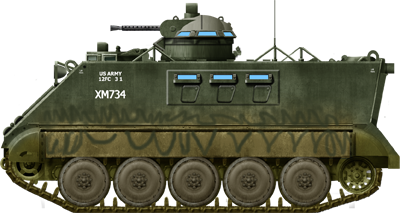
First prototype XM734, with a tailored barrel-like tower and cupola. Note the early three side gun ports.
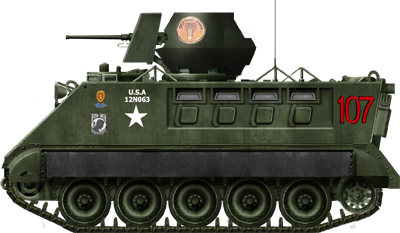
The later N°5 XM734 with ACAV and operational markings, allegedly seeing service in Vietnam, but this is dubious to say the least. read more
Photos

Basic XM-734
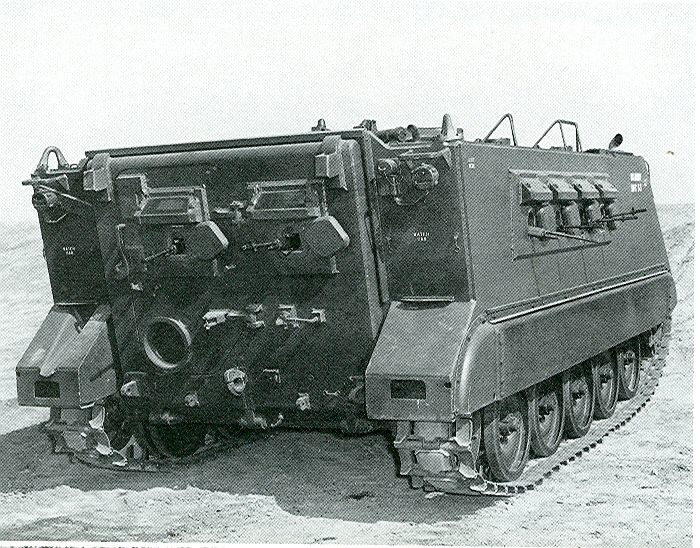
XM734 showing its gun ports
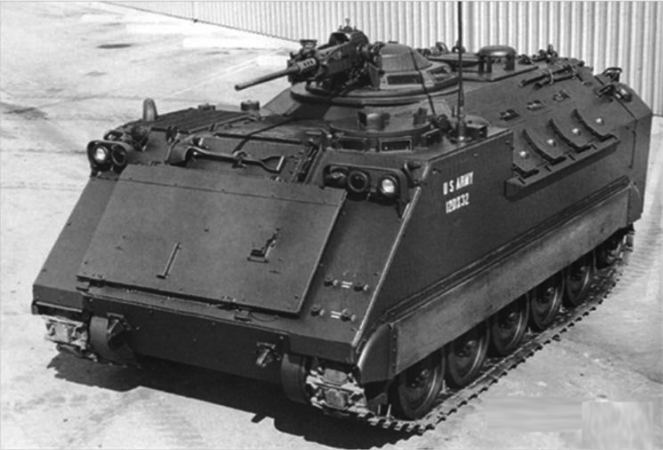
The next evolution of the concept, the XM-765
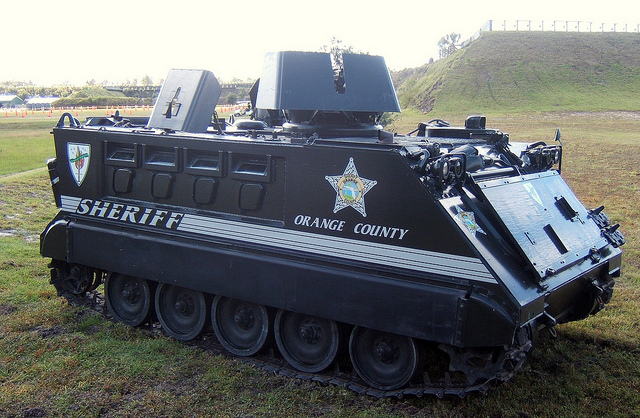
County Sheriff's XM734
More
Books
Zaloga, Steven and Sarson, Peter. M2 / M3 Bradley Infantry Fighting Vehicle 1983 - 1995, Osprey (UK) Ltd, 1995, London, New Vanguard Series No. 18.Links
3. Integrating Dismounted Infantry Capabilities with Combat Vehicles - JSTOROn russian-tanks.com
M701 on globalsecurity.org
On btvtinfo.blogspot.com
Full development on historyofwar.org
toadmanstankpictures.com walkaround
On reddit, tankporn. Allegedly served both in Vietnam and was evaluated by Israel for conversion of existing M113s.
On combatreform.org
A police-converted XM765 on tankandafvnews.com
On hagerty.com
ultimate_gavin
Army documentary extract on the XM734
Model kit conversion kit for M113
Videos: XM734 running

Cold War Tanks


































Cold war tanks posters

Cold War Main Battle Tanks

Cold War Soviet Army
Museums, Movies, Books & Games
The Tanks and Armor in pop culture
Tanks and armored vehicles in general are only really grasped when seen first person: The mass, the scale, it's all there. Explore also the way tanks were covered in the movie industry, in books and in video games.Movies:
Best tanks movie on warhistoryonline.com
On imdb.com
On bestsimilar.com/
miltours.com
liveabout.com/
watchmojo.com
Video Games:
pcgamesn.com
historyhit.com
levvvel.com
vg247.com/best-tank-games
mmobomb.com/
alienwarearena.com

